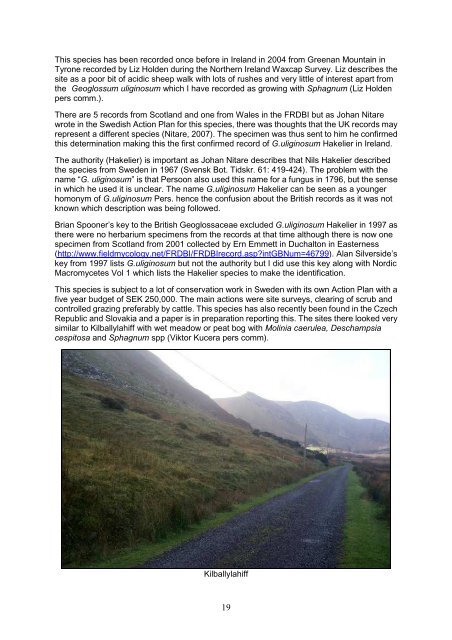North Kerry Waxcap Survey 2012 - the Northern Ireland Fungus Group
North Kerry Waxcap Survey 2012 - the Northern Ireland Fungus Group
North Kerry Waxcap Survey 2012 - the Northern Ireland Fungus Group
Create successful ePaper yourself
Turn your PDF publications into a flip-book with our unique Google optimized e-Paper software.
This species has been recorded once before in <strong>Ireland</strong> in 2004 from Greenan Mountain in<br />
Tyrone recorded by Liz Holden during <strong>the</strong> <strong>North</strong>ern <strong>Ireland</strong> <strong>Waxcap</strong> <strong>Survey</strong>. Liz describes <strong>the</strong><br />
site as a poor bit of acidic sheep walk with lots of rushes and very little of interest apart from<br />
<strong>the</strong> Geoglossum uliginosum which I have recorded as growing with Sphagnum (Liz Holden<br />
pers comm.).<br />
There are 5 records from Scotland and one from Wales in <strong>the</strong> FRDBI but as Johan Nitare<br />
wrote in <strong>the</strong> Swedish Action Plan for this species, <strong>the</strong>re was thoughts that <strong>the</strong> UK records may<br />
represent a different species (Nitare, 2007). The specimen was thus sent to him he confirmed<br />
this determination making this <strong>the</strong> first confirmed record of G.uliginosum Hakelier in <strong>Ireland</strong>.<br />
The authority (Hakelier) is important as Johan Nitare describes that Nils Hakelier described<br />
<strong>the</strong> species from Sweden in 1967 (Svensk Bot. Tidskr. 61: 419-424). The problem with <strong>the</strong><br />
name “G. uliginosum” is that Persoon also used this name for a fungus in 1796, but <strong>the</strong> sense<br />
in which he used it is unclear. The name G.uliginosum Hakelier can be seen as a younger<br />
homonym of G.uliginosum Pers. hence <strong>the</strong> confusion about <strong>the</strong> British records as it was not<br />
known which description was being followed.<br />
Brian Spooner’s key to <strong>the</strong> British Geoglossaceae excluded G.uliginosum Hakelier in 1997 as<br />
<strong>the</strong>re were no herbarium specimens from <strong>the</strong> records at that time although <strong>the</strong>re is now one<br />
specimen from Scotland from 2001 collected by Ern Emmett in Duchalton in Easterness<br />
(http://www.fieldmycology.net/FRDBI/FRDBIrecord.asp?intGBNum=46799). Alan Silverside’s<br />
key from 1997 lists G.uliginosum but not <strong>the</strong> authority but I did use this key along with Nordic<br />
Macromycetes Vol 1 which lists <strong>the</strong> Hakelier species to make <strong>the</strong> identification.<br />
This species is subject to a lot of conservation work in Sweden with its own Action Plan with a<br />
five year budget of SEK 250,000. The main actions were site surveys, clearing of scrub and<br />
controlled grazing preferably by cattle. This species has also recently been found in <strong>the</strong> Czech<br />
Republic and Slovakia and a paper is in preparation reporting this. The sites <strong>the</strong>re looked very<br />
similar to Kilballylahiff with wet meadow or peat bog with Molinia caerulea, Deschampsia<br />
cespitosa and Sphagnum spp (Viktor Kucera pers comm).<br />
Kilballylahiff<br />
19


